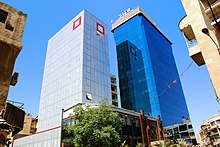 Bank Al-Sharq and the Blue Tower Hotel in Damascus | |
| Currency | Syrian pound (SYP) |
|---|---|
| Calendar year | |
Trade organisations | CAEU, GAFTA, G24, G77, World Bank, IMF |
Country group |
|
| Statistics | |
| Population | |
| GDP | $22.4 billion (nominal; 2019 est.)[5] $57.25 billion (PPP; 2015 est.)[2]/$136 billion (PPP; 2021 est.)[citation needed] |
| GDP rank | |
GDP growth | |
GDP per capita | $6.373 (PPP; 2021)[6] |
GDP by sector |
|
Population below poverty line | 82.5% (2014 est.)[2] |
Labour force | |
Labour force by occupation |
|
| Unemployment | |
Main industries | Petroleum, textiles, food processing, beverages, tobacco, phosphate rock mining, cement, oil seeds crushing, car assembly |
| External | |
| Exports | |
Export goods | olive oil, spices, barley, nuts, cotton, tomatoes, soap, phosphates, cumin seeds, pistachios, glass, cleaning products, apples, pears, potatoes, and some pitted fruits (2021)[12] |
Main export partners | |
| Imports | |
Import goods | cigarettes, tobacco, raw sugar, motor vehicles, broadcasting equipment, wheat flours, sunflower oil, liquefied petroleum gas, associated petroleum gas, refined petroleum, coffee and rice (2021)[12] |
Main import partners | |
Gross external debt | |
| Public finances | |
| Revenues | $2.7 billion (2021 est.) |
| Expenses | |
| Economic aid | humanitarian aid $7.7 billion (2020 est.)[13] |
All values, unless otherwise stated, are in US dollars. | |
Syria's economic situation has been turbulent and their economy has deteriorated considerably since the beginning of the Syrian civil war, which erupted in March 2011.[14][15]
- ^ "World Economic Outlook Database, April 2019". IMF.org. International Monetary Fund. Retrieved 29 September 2019.
- ^ a b c d e "MIDDLE EAST :: SYRIA". CIA.gov. Central Intelligence Agency. Retrieved 29 December 2019.
- ^ "World Bank Country and Lending Groups". datahelpdesk.worldbank.org. World Bank. Retrieved 29 September 2019.
- ^ "Population, total – Syrian Arab Republic". worldpopulationreview.com. World population review. Retrieved 1 January 2022.
- ^ "GDP Syrian Arab Republic". worldbank.org. World Bank. Retrieved 29 December 2022.
- ^ "GDP per capita (current US$) - Syrian Arab Republic". World Bank. Retrieved 22 July 2022.
- ^ "Inflation, consumer prices (annual %) - Syrian Arab Republic". World Bank. Retrieved 1 May 2022.
- ^ "Human Development Index (HDI)". hdr.undp.org. HDRO (Human Development Report Office) United Nations Development Programme. Retrieved 11 December 2019.
- ^ "Inequality-adjusted Human Development Index (IHDI)". hdr.undp.org. HDRO (Human Development Report Office) United Nations Development Programme. Archived from the original on 12 December 2020. Retrieved 11 December 2019.
- ^ "Labor force, total – Syrian Arab Republic". data.worldbank.org. World Bank. Retrieved 1 January 2022.
- ^ "Unemployment, total (% of the total labor force) (modeled ILO estimate) – Syrian Arab Republic". data.worldbank.org. World Bank & ILO. Retrieved 5 April 2020.
- ^ a b c d e f "Foreign trade partners of Syria". The Observatory of Economic Complexity. Retrieved 19 July 2022.
- ^ Robin Emmott (30 June 2020). "U.N. raises $7.7 billion for Syrians beset by war and COVID-19". Reuters. Retrieved 2 January 2022.
- ^ CIA World Fact Book – Syria's Economy. Cia.gov.
- ^ "Syria: The story of the conflict". BBC News. 11 March 2016. Retrieved 26 July 2021.
Cite error: There are <ref group=note> tags on this page, but the references will not show without a {{reflist|group=note}} template (see the help page).